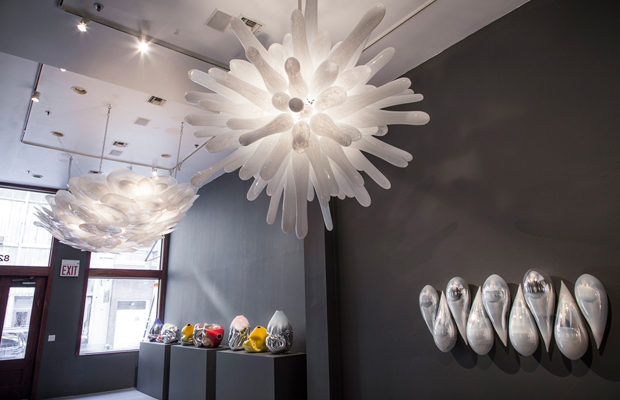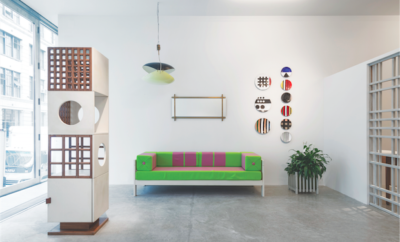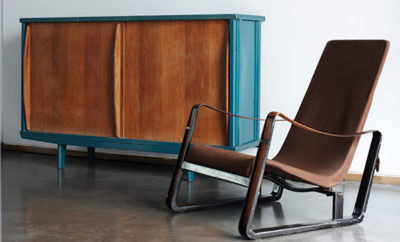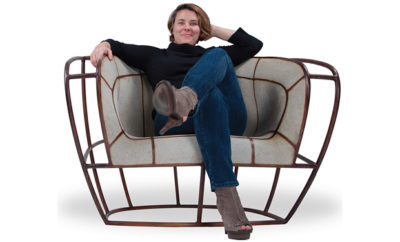 Installation view of Jeff Zimmerman show at R & Company, 2014, including Zimmerman’s chandeliers Unique Galaxy Cluster of 2013 and Unique Explosion Bubble Cluster of 2014, as well as Yin-Yang-Yin-Yang-Yin-Yang-Yin-Yang-Yin, a sculptural grouping of nine wall-mounted drops in hand-blown, mirrorized opaline glass, 2014.
Installation view of Jeff Zimmerman show at R & Company, 2014, including Zimmerman’s chandeliers Unique Galaxy Cluster of 2013 and Unique Explosion Bubble Cluster of 2014, as well as Yin-Yang-Yin-Yang-Yin-Yang-Yin-Yang-Yin, a sculptural grouping of nine wall-mounted drops in hand-blown, mirrorized opaline glass, 2014.
Exhibition
Contemporary Glass Goes Global
INTERNATIONALLY, DEALERS SPOTLIGHT NEW FORMS AND APPROACHES IN GLASS
The sheer number of artists Using glass in new and novel ways has grown exponentially. “A marked change is that key artists around the world are transforming this specialty by creating sculptural work, incorporating twentieth-century and later palettes, and applying new techniques,” says Tina Oldknow, curator of modern glass at the Corning Museum of Glass. “They are affirming that this field is no longer sequestered in the craft arena.” In December the Corning Museum will debut twenty-six-thousand-square feet of new gallery space that, Oldknow says, will ”highlight the degrees to which artists are moving far beyond purely functional forms and traditional methodologies and dissolving the boundaries between the decorative arts, fine art, and design.”
Another relatively recent development is that dealers with prominent artists who specialize in glass are now taking part in top-tier art and design fairs.
Adrian Sassoon of London has long been at the forefront of showcasing leaders of glass artistry. Sassoon’s stable of acclaimed artists includes Danny Lane, with his craggy glass objects—even tables—and Rachel Woodman, known for her vessels in primary colors. R and Company in New York’s Tribeca (this is the recently renamed denizen of design, R20th Century) features artist Jeff Zimmerman, who turns out sculptures of hand-blown mirrored glass and enormous chandeliers with numerous hand-blown globes, attracting collectors from both here and abroad.
In Philadelphia, Lewis Wexler, whose fifty-six-hundred-square-foot Wexler Gallery is located in the Old City section, is seeing a decided uptick in interest in glass. He began his career in the arts in the late 1980s as assistant vice president of twentieth-century decorative arts at Christie’s and later worked with French art deco dealer Anthony DeLorenzo.
“Glass artist Andy Paiko, whose studio is in Portland, Oregon, epitomizes the movement to design,” Wexler says. His Optic Twist Screen #2, which measures ten feet in width and is composed of more than forty hand-blown glass objects, was just acquired by the Chazen Museum of Art at the University of Wisconsin-Madison. Wexler’s exhibition Andy Paiko: New Work runs through April 26. “Now clients with significant collections of contemporary art, with work by Chuck Close, Julian Opie, and Ross Bleckner, are seeking Andy’s large scale screens, Dale Chihuly vessels, and William Morris’s latest creations as well,” Wexler says, adding, “such crossover collecting is no longer a rarity.” Wexler takes part in SOFA Chicago as well as the May Collective 2 Design Fair in New York. His client list includes collectors in Britain, Germany, and France as well as in the States.

Optic Twist Screen #2 constructed of hand blown glass, steel, and walnut by Andy Paiko, 2013.
Washington, D.C., dealer Maurine Littleton carries on the legacy of her father, the pioneering studio glass artist and educator Harvey K. Littleton, who died in December, and in addition represents several other artists. “With our gallery located in an international hub, we reach a global audience with a clientele also based in France, Sweden, Saudi Arabia, and even further abroad,” Littleton says. On view at the gallery now is her father’s 1989 Lemon/Red Sliced Descending Form, a curvilinear furnace-worked solid piece of glass with concentric layers of those tones. The price is $45,000. For his Still Life with Books and Gilded Lens, British artist Colin Reid used books as a mold for optical glass. It is tagged at $15,000. This spring, Littleton will mount an exhibition celebrating the gallery’s thirtieth anniversary, though details had not been released when MODERN went to press. She also participates in SOFA Chicago.

Arc Segment, Balanced from 1981 by Harvey K. Littleton, a pioneer of the Studio Glass movement. Littleton used multiple cased overlays of color to create his arcs.
Considered the epicenter of glass-blowing artistry in the United States, Seattle is home to Traver Gallery, which has long showcased major studio glass artists, including Dante Marioni and Laura de Santillana. “We’ve been excited to see a group of artists pushing glass in new directions, particularly with regard to surface,” says Sarah Traver, who since 2004 has run the gallery with her father, William. She cites John Kiley, who pairs transparent and polished mirrored surfaces “to create complex and dynamic optics,” and April Surgent, who combines age-old craft with contemporary technology, using digital photography as a springboard for her cameo engraving process on glass panels and blown forms.

Broken Chalice with Flute by Beth Lipman, 2014.
New York’s Chelsea district is home to the nation’s largest concentration of contemporary fine arts galleries. Some, such as the twenty-two-year-old Claire Oliver Gallery, also feature artists who work in glass. Oliver represents glass artists Beth Lipman and Andrew Erdos as well as a number of contemporary fine art masters. Lipman takes inspiration from Renaissance and Baroque still life paintings as the basis for her art. Her recent Broken Chalice with Flute typically combines a jumble of tabletop objects in transparent blown glass, some damaged or shattered. “Beth explores the fragility and transient nature of life,” Oliver says, adding that this artist’s work is finely crafted but by no means falls into the category of “craft.” Examples by Lipman can be found in the Smithsonian American Art Museum, the Brooklyn Museum, and the Norton Museum of Art in West Palm Beach.
Oliver’s collectors also favor emerging artist Andrew Erdos. He brings glass into mainstream fine art by incorporating liquid silver in his pieces, which are executed in a pop art palette. “In Andrew’s works there exists a situation that is overwhelming to the senses and in many ways a representation of daily life,” Oliver says. “When all your senses are activated is oftentimes when there is a moment of clarity,” she adds, pointing to the Brooklyn artist’s Cheerfully Rooting Through Ruby Red Detritus, which also incorporates two-way mirror glass and so, like much of his work, brings the viewer’s own reflection into the piece. Oliver takes part in Art Miami.

Kookaburra by Lino Tagliapietra, blown glass, 2014.
One of the newest additions to the Chelsea district is the well-established Heller Gallery, which specializes in glass. “We moved our gallery from the meatpacking section to Chelsea to highlight the importance of glass in the contemporary art world,” says co-owner Doug Heller. The gallery has long featured the glass of the Czech husband and wife team of the late Stanislav Libenský and Jaroslava Brychtová, who is now nearly ninety and still oversees casting. “Collectors are drawn to the monumentality of their cast glass sculptures with some measuring over six feet in height,” Heller says. Influenced by Czech cubism, Libenský and Brychtová’s work can be found in the Metropolitan Museum of Art, LACMA, the Musée des Arts Décoratifs in Paris, and the National Museum of Modern Art in Kyoto. Their work ranges from $25,000 to $500,000.
Venetian glassblower Lino Tagliapietra, who works on the island of Murano, is also high on collectors’ lists, according to Heller. “His pieces grow in scale without compromising the complexity of his designs, which are rich in carved surfaces,” he says. The gallery will have a spring show dedicated to Tagliapietra, May 2–31, and Heller also takes part in SOFA Chicago and Art Miami.
The London establishment Sylvia Powell Decorative Arts specializes in ceramics, with nineteenth-century examples by William de Morgan and Jacques Lehmann among others, but those in the know know that she also offers glass by such twentieth-century artists as Jean Cocteau, Max Ernst, and Picasso. Especially striking is Picasso’s 1960 Il Volto, a blue glass head with horns for $110,000. Also of note is a sea green glass plaque by Cocteau from 1962 titled Festaioli Veneziani, depicting raised dancing figures with a gondola in the rear for a modest $7,000.“Both collectors of glass and contemporary art find glass by key twentieth-century artists captivating,” says Mark Murray, who works with his mother in the gallery.

Il Volto by Pablo Picasso and Egidio Costantini, c. 1960. Costantini collaborated with renowned contemporary artists to create glass sculptures.
Sylvia Powell participates in the New York Ceramics Fair, the American International Fine Art Fair, Miami Art and Design, and all the important London fairs—BADA Antiques and Fine Art Fair, Art Antiques London, and LAPADA Art and Antiques Fair.
On Venice’s glassmaking island of Murano, Berengo Studio, launched by Adriano Berengo in 1989, has focused on working with important contemporary artists.“We have invited Jaume Plensa, Tracey Emin, and others to explore the material of glass, and, with the help of our glass masters, to translate their concepts and drawings into new expressions of artistry,” says Adriano’s son Marco, who is now the firm’s executive director.
In 2009 Adriano launched Glasstress, which runs concurrently with the Venice Biennale. Last year’s version (which took place at the Berengo Center of Contemporary Art) included Plensa’s 2013 Blake in Venice, with its ribbons of cast ocher-color Murano glass letters that spell out portions of William Blake’s Proverbs of Hell. It was priced at $126,000. Also on view was work by Thomas Schutte and Cai Guo-Qiang, and other major artists like Tracey Emin, Tony Oursler, Ilya and Emilia Kabakov, and Ron Arad.

Blake in Venice by Jaume Plensa, 2013.
Berengo Studio participates in a wide range of fairs, including SOFA Chicago, Design Miami Basel, Art Paris, KunstRAI Amsterdam, and Art Cologne. At Art Palm Beach this year, Berengo featured the work of the American artist Zak Timan. Zak makes “floating sculptures”—compositions of small buoyant elements that float in clear, oil-filled glass vessels. One example is his recent Rhapsody in Midnight priced at $14,000 and part of a series that also includes Rhapsody in Red.
Hans-Martin Lorch, who heads up Lorch and Seidel Contemporary in Berlin is seeing a growing interest in glass that specifically crosses over into contemporary sculpture and painting. A wide range of collectors is gravitating toward the art glass of the German-born painter Mindy Weisel, who now lives in Washington, D.C., and Jerusalem. She creates panels by fusing and then kiln-firing several thin glass sheets. Her Queen of Oranges—the bottom sheet is silk-screened and the top layer is painted with five brilliant oranges—approaches abstract painting.

Queen of Oranges, painting and screen print on glass by Mindy Weisel, 2012.
Also prominent at Lorch’s gallery is the work of Berlin-based Wilken Skurk, whose cast-glass and metal sculptures include the highly architectonic Power, in patinated bronze and cast glass. The price is $55,000. “Many of Skurk’s larger examples are favored by collectors for their gardens,” says Lorch, who will take part in the inaugural Art and Design New York fair, which takes place May 8 to 11. He reports that Americans make up 20 percent of his client list.

Power, in cast glass and patinated bronze, by Wilken Skurk, 2008.
In Paris, on the Right Bank, the Clara Scremini Gallery specializes in both contemporary glass and ceramics. Since opening in 1985, Scremini has sold more than eighty works to various museums, including the Musée des Arts Décoratifs, the Musée Guimet, the Corning Museum of Glass, the Musée de Design et d’Arts Appliqués Contemporains in Lausanne, Switzerland, and the Victoria and Albert Museum in London.

Kolosa in engraved blown glass by Gérald Vatrin, 2013.
Scremini reports that her clients are attracted to the work of Gérald Vatrin who engraves geometric patterns on his blown glass, creating pieces that are a “totally new sculptural interpretation of glass.” Also at Scremini is glass by Hungarian GyÖrgy Gáspár, who lives in Budapest and creates geometric forms, many with a Day-Glo-like palette of magenta and brilliant blues and yellows. “Clients find that his sleek sculptures fit into their contemporary art collections as well as alongside period antiques,” Scremini says. Prices for his work run up to $17,000.
Lesley Kehoe Galleries in Melbourne, Australia, may seem an unlikely spot to attract American collectors. But 50 percent of Kehoe’s clients are from the States. “My collectors are seeking work beyond the routine multicolored vessels,” he says.
One artist he favors is Masahiro Asaka of Japan, whose ice-like glass with crystalline edges approaches abstract sculpture. “One collector of Masa has Francis Bacon paintings and both contemporary and antique Japanese lacquer, indicating how such glass complements a varied range of fine art and decorative arts,” Kehoe says. Masa’s work is in the $25,000 range.

Surge 16.2 by Masahiro Asaka, 2012, in cold-worked cast glass.
Mel Douglas is another artist who is pursued internationally, according to Kehoe. Her creations in blown black glass contrast matte and luster finishes achieved with stippling and engraving. Kehoe regularly takes part in Asia Week New York, Art Antiques London, and the Sydney Contemporary Art Fair.












